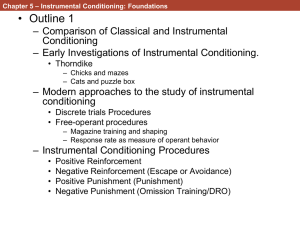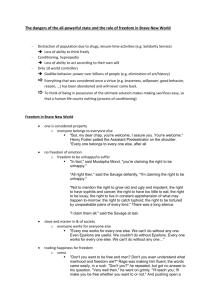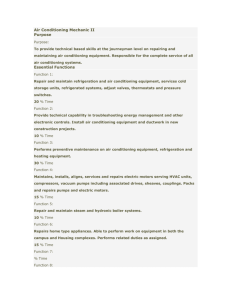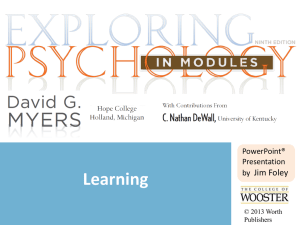Slides - computation + cognition lab @ nyu
advertisement
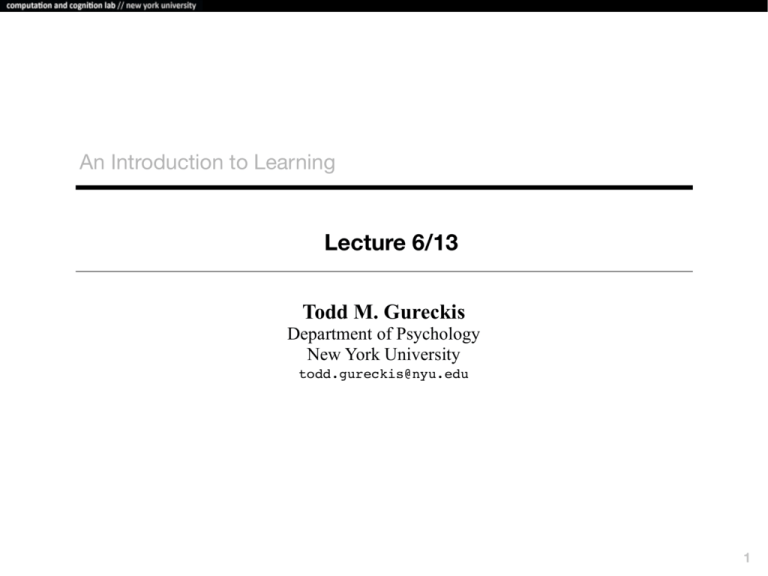
An Introduction to Learning Lecture 6/13 Todd M. Gureckis Department of Psychology New York University todd.gureckis@nyu.edu 1 Agenda for Today Instrumental Conditioning Basic terms, concepts, the law of effect Various oddities about instrumental conditioning (superstition, learned helplessness, stimulus control over response, devaluation) Schedules of reinforcement and the matching law Multiple representations of actions (S-R versus R-O, modelbased/model-free RL) 2 1 Answers to your questions 3 Questions 1. Does training a CSA- and a CSB+ to separately predict a outcome, then putting them in a second-order conditioning experiment lead to reversals? What would the time course be? 2. Does the TD signal really pass slowly backwards in time? 3. Is the neuro-modulatory effect of interneurons the same as the sensitization involved with cocaine? 4. Does the Kalman filter react quickly to sudden task changes such as in reversal learning? 4 Q1 Does training a CSA- and a CSB+ to separately predict a outcome, then putting them in a second-order conditioning experiment lead to reversals? What would the time course be? Perhaps not exactly the same, but see Konorski (1948) experiment 5 Q2 Does the TD signal error really pass slowly backwards in time? 1. The prediction of TD on this is slightly misattributed. In computer science, the TD we discussed is more like TD(0). There are other versions that include “eligibility traces” which can “backpropogate” faster than TD(0). Null results on finding the “backup” could be operation of TD(lambda) 2. Also, representation of time is likely wrong in simplistic TD model (Suri & Schultz, 1999; Daw, Courville, & Touretzky, 2002) 3. Some paper claim null effects (supporting a ET theory), Fiorillo, Tobler, & Schultz found tonic response during interstimulus interval during probabilistic task (which constantly adjusting error term). see Niv paper for full explanation 6 Thanks to N. Daw for his input on this. Q3 Is the neuro-modulatory effect of interneurons the same as the sensitization involved with cocaine? Fun Fact: Many street and prescription drugs work by modulating the neurotransmitter systems. Answer: The answer stands. No goal. 7 Q4 Does the Kalman filter react quickly to sudden task changes such as in reversal learning? 8 1. Adaptation can be relatively fast, esp. when error jump 2. There is also possibility of meta-learning (learning to learn) about change rates/ volatility 3. Behrens paper showed people adjusted learning rate near optimally based volatility of environment (as predicted by Kalman filter) 4. For reversal tasks involve discrete hypothesis that flip/mode swtich (Wisconsin card sorting task) the tracking behavior of the Kalman filter may be less appropriate. 2 Instrumental Conditioning 9 Pavlovian (Classical) Conditioning Learning predictions about biologically important events Outcomes (like food) are not contingent on behavior Instrumental Conditioning Learning to take actions Outcomes are contingent on behavior aka “operant conditioning” 10 Pavlovian (Classical) Conditioning Learning predictions about biologically important events Outcomes (like food) are not Most dependable contingent on behavior difference is about the contingency between action. Many aspects of classical Instrumental Conditioning conditioning and instrumental are Learning to take actions the similar (e.g., extinction, learning curves, etc...) Outcomes are contingent on behavior aka “operant conditioning” 11 Edward Thorndike Law of Effect Situation Response “Of several responses made to the same situation, those which are accompanied or closely followed by satisfaction to the animal will, other things being equal, be more firmly connected with the situation, so that, when it recurs, they will be more likely to recur; those which are accompanied or closely followed by discomfort to the animal will, other things being equal, have their connections with that situation weakened, so that, when it recurs, they will be less likely to occur” (Thorndike, 1911) reward 12 Edward Thorndike Law of Effect 13 Edward Thorndike Law of Effect According to Thorndike, the reinforcer “stamps in” the association between the situation and some action Reinforcer not needed after training: behavior becomes habitual No need to assume more intelligence of causal learning/insight Automatic learning process one there is a goal (motivation) 14 Edward Thorndike Law of Effect Many determinants of responding: Drive/motivation - affects learning and performance Reward magnitude & contrast effects Delay to reward (long time general leads to slower learning) Frequency of reinforcement (continuous versus partial) Instrumental conditioning as a form of adaptive control over the environment: animal behaves such as to bring about good things and avoid bad things 15 “Skinner Box” developed the “free-operant” procedure 1. Hungry rat pressed a lever for food 2. Some programmed relationship between presses & rewards (“schedule”) 3. Main dependent variable: response rate (also timing, pattern, vigor), as a function of schedule 16 Superstition 17 Reinforcement (food) at fixed intervals leads to strange, stereotyped behavior like dancing and thrusting head into the corner of the cage, etc... Humans do it ! 18 Reinforcement (food) at fixed intervals leads to strange, stereotyped behavior like dancing and thrusting head into the corner of the Not cage, just etc... a clever experiment (the first Psych Science paper?!) Humans do it ! Demonstrates contiguity between ongoing actions and rewards in driving instrumental learning (consistent with Thorndike’s hypothesis). 19 Maybe not... Only terminal responses (pecking) increase at the end of the fixed time interval In-between (interim responses) were less conditioned but may reflect based aspects of the way organisms search for food when hungry (the superstitious behavior is just the way pigeons forage!) Pre-organized, species-specific patterns of foraging and feeding behaviors ... a search strategy! Superstition? See Timberlake & Lucas, 1989; Staddon & Simmelhag, 1971 20 The concept of “Belongingness” Just as certain CS-US relationships are easier to acquire, certain behaviors are easier to condition instrumentally (remember Garcia & Koelling, 1966 finding on conditioning tastes/sickness/shock): Harder to get cats to condition grooming to escape relative to playing with strings (Thorndike) At zoo pigs trained to drop coin in a slot try kicking it rather than dropping with mouth ...and raccoons keep playing with the coins and never dropping them in (Breland & Breland, 1961) and yet instrumental conditioning remains incredibly powerful... http://www.youtube.com/watch?v=Nc9xq-TVyHI 21 Learned Helplessness Seligman & Maier, 1967 Animals given painful shocks at random intervals, other group could perform action to avoid shock Subsequently put in new situation where could learn action to avoid a shock. Only the group that had control in the first part learned. Typical interpretation is that animals who lacked control learned there was nothing they could do to escape shocks (learning to learn?) Violation of “Law of Effect”!? Shows important of reward salience, interpretation of the task, and general knowledge states on instrumental conditioning A possible animal/learning model for certain forms of depression? 22 1. Hungry rat presses a lever for food 2. Some programmed relationship between presses & rewards (“schedule”) 3. Main dependent variable: response rate (also timing, pattern, vigor), as a function of schedule “Skinner Box” 4. (sometimes) there is a stimulus (S) that appear before the response that alerts the animal that the response is available/ warranted “free-operant” procedure S stimulus R response 23 O outcome Curious Stimulus Effects (operate outside of reward to control behavior) Habit slip: rats in a maze will run right past a food bowl on their way to where they expect reward (the maze stimulus is controlling behavior in a powerful way) (Stoltz & Lott, 964) Pressing the 4th floor button when you work on the 8th floor Protestant ethic effect: pigeons learn first to perform an action for food while an empty food well is in their cage. Later free food placed in the well. Prefer to work for the food than get the open reward. (Neuringer, 1969) 24 Instrumental Responses Shaping: the process of slowing building up more complex behaviors through strategic reinforcement Basically reward successive approximations of the desired behavior To teach bird to peck at hopper for food, first reinforce movement toward the hopper, then for contact with the lever, the closer and closer to desired behavior Autoshaping: just light up response button and give reward at fixed intervals, eventually pigeon will automatically start tapping button and getting reward. Chaining: building up sequences of actions one after another. Usually best to start with things closer to final reward (last action in chain) and go backwards (something predicted from TD(λ)) 25 Instrumental Conditioning and Motivation (we’ll have more to say about this next time) pecks emitted per minute Typical finding: Increase the # of pecks required for food, animals wonʼt work as hard Make rats less hungry, they donʼt work as hard Puzzle:: Why donʼt animals just work as hard as possible to get the reward? pecks required per reinforcer (Foster et al 1997) 26 Schedules of Reinforcement 1 Ratio schedules Rewarded after N leverpresses Variable ratio (VR): N is randomized, with some average requirement (VR30: 1/30th of leverpresses are rewarded) 2 Interval schedules Reward becomes available T seconds after last one is retrieved If T is fixed (say 30s) how should you behave? Variable interval (VI): T in randomized (VR30: every second there is a 1/30th chance reward will become available) now how should you behave? 27 Schedules of Reinforcement 28 Contingency Effects Response/CS No response/No CS US/Reinforcer No US/No Reinforcer a c b d Contingency = p(US|CS) - P(US/no CS) = [a/(a+b)] - [c/(c+d)] Each cell always visited Not necessarily the case in in classical case (set up instrumental... have to sample or by experimenter) EXPLORE cells to gain information 29 Relating learning, choice, and the ‘Strength’ of responding Concurrent schedules! --- Akin to an N-armed bandit in computer science: Put out multiple levers with different reward schedules and let the animal choose between them Say on lever make food available, on average, 30 secs after you pick it up, the other on average, 60 seconds what should you do? 30 The Matching Law Animals share responses between levers % responses on key A 100 1. Favor the richer option proportionally more Pigeon 1 Pigeon 2 Perfect matching 80 2. In the variable interval task, this is nearly optimal 60 40 The Matching Law 20 % of A choices matches % rewards on A 0 20 40 60 80 100 % reinforcements on key A (Herrnstein, 1961) C(A): # of A choices r(A): # of times A rewarded 31 The Matching Law Matching law holds when magnitudes of rewards are manipulated (keeping arming intervals constant): In this case, matching is the proportion of total reward received from a choice 2. In the variable interval task, this is nearly optimal The Matching Law % of A choices matches % rewards on A C(A): # of A choices r(A): total reward from A 32 The Matching Law Data is a list of choices (order invariant): Ignores facts like pacing of responding, how fast/often they choose Is it applicable to discrete trial problems (i.e., not free operant)? Is the matching law a description or a process? Focuses on overall, stead-state responses: prediction is about aggregate of statistics over a large number of repeated choices doesn’t say anything about learning itself 33 Optimal foraging behavior Ideal Free Distribution (Fretwell & Lucas, 1972; Seth, 2001) Interestingly, animals distribute themselves among patches so as to maximize the gained resources. Equilibrium achieved when no organism can profit from moving elsewhere. Harper (1982) 34 Godin & Keenleyside (1984) Even human groups! Goldstone & Ashpole (2004) (well they undermatch a bit) 35 The Matching Law So far discussion has been focused on interval schedules What about choice between ratio schedules? Level A pays off with 1/30 probability (VR30) Lever B pays off with 1/60 probability (VR60) Now what should you do? 36 The Matching Law So far discussion has been focused on interval schedules What about choice between ratio schedules? Level A pays off with 1/30 probability (VR30) Lever B pays off with 1/60 probability (VR60) Now what should you do? MAXIMIZE! Choose A, never B! 37 The Matching Law In the ratio situation maximizing is matching! Any differential allocation of choice to option A will result in more reward for that option than for B. By that logic this should increase allocation to A until, in the limit, exclusively A is chosen. Thus, the matching law doesn’t necessarily predict matching behavior 38 The Matching Law - Summary Variable interval task: Variable ratio task: Common sense: divide choices between levers (because a neglected choice will eventually be baited) Common sense: choose richer option exclusively (it is a better bet) Matching law predicts: choose richer option exclusively Matching law predicts: divide choices between levers Animals do - generally choose the better option exclusively Animals do - divide choices 39 Explanations for matching Herrnstein & Prelec (1991) : Theory of melioration Anticipation by our discussion of group foraging. 1. People track average satisfaction or value per unit invested in each alternative 2. Melioration: based on these values, they shift behavior/choices to alternatives that provide a higher per-unit return Can be tested in dynamic tasks there contingencies are linked to subject’s previous choices. 40 Other tidbit: The Premack principal We don’t ONLY go around chasing primary rewards In some cases, limiting animals access to a behavior they WANT to do naturally can act as reinforcement... known as the Premack principal Basically for kids, watching TV is a preferred activity to homework. By limiting TV access, TV can become a reward for doing homework Premack (1959) gave rats free access to running wheel and water. Spent 250 seconds running and 50 seconds drinking. Then, set up contingency where could only run after drank a certain amount. Rats learn contingency and increase water drinking to gain access to wheel. 41 What is learned in instrumental conditioning? Thorndike Situation Skinner Response reward 42 Tolman Remember Latent Learning? 43 Tolman’s point Previously, we talked about Tolman’s ideas/work as evidence that animals learn (in an unsupervised fashion) an “internal model” of their environment A second key point we didn’t emphasize is that they USE this “cognitive map” to PLAN BEHAVIORS 44 The modern debate: S-R or R-O S-R theory: Parsimonious - same theory for Pavlovian conditioning (CS/CR pairing) But it overlook the critical contingency in instrumental conditioning between the response and outcome alternative: R-O theory (or A-O) proponents: Rescorla, Dickinson, et al. same spirit as Tolman (know ‘map’ of contingencies and desires, and can use this to plan... maybe INFORMATION PROCESSING!) 45 A good test: Outcome devaluation 46 A good test: Outcome devaluation Holland (2004) see also Dickinson article for examples 47 A good test: Outcome devaluation Holland (2004) see also Dickinson article for examples Suggests some measure of reward or outcome expectancy (shifts to habitual control with extensive training) 48 Goal directed vs. Habitual Behavior “Cognitive” vs. “Associationist” 49 Goal directed vs. Habitual Behavior “Cognitive” vs. “Associationist” Be very afraid. The rats of NIHM are really smart! 50 Devaluation and Lesions Systematic patterns of behavior in devaluation studies suggest distinct neural pathways involved in either the goal-directed or habitual system Animals with lesion to Dorsolateral Striatum (DLS) never develop habits despite extensive training Also happens with drugs that deplete dopamine in DLS Also happens with lesions to infralimbic division of PFC (same corticostriatal loop) 51 Yin et al. (2004) - Slides from Y. Niv Devaluation and Lesions Systematic patterns of behavior in devaluation studies suggest distinct neural pathways involved in either the goal-directed or habitual system After habit have been formed, devaluation sensitivity can be reinstated by temporary inactivation of IL PFC 52 Coutureau & Killcross (2003) - Slides from Y. Niv Devaluation and Lesions Systematic patterns of behavior in devaluation studies suggest distinct neural pathways involved in either the goal-directed or habitual system Lesions of posterior Dorsomedial Striatum (pDMS) cause habitual leverpressing even with moderate training Yin, Ostlund, Knowlton, & Balleine (2005) - Slides from Y. Niv 53 Devaluation and Lesions Systematic patterns of behavior in devaluation studies suggest distinct neural pathways involved in either the goal-directed or habitual system Prelimbic (PL) PFC lesions cause animals to leverpress habitually even with only moderate training (along with dmPFC and mediodorsal thalamus which are in same loop). Killcross & Coutureau (2003) - Slides from Y. Niv 54 What does it mean? 55 This... The same action (lever pressing) can arise from psychologically & neurally dissociable pathways: Moderately trained behavior is “goal-directed”: dependent on outcome representations, like planning with a cognitive map Overtrained behavior is “habitual”: not dependent on outcome representation, as predicted by S-R theory Which is right S-R or R-O? probably BOTH! Lesions suggest that two parallel systems interactively contribute to behavior in any situation 56 The take-home for today Instrumental conditioning is a form of adaptive control over the environment: the animal behaves such as to bring about good things and avoid bad things Way more complex than classical conditioning. True understanding involves theories of choice, motivation, reward valuation, planning, impulse control, stimulus processing and generalization, theories of response rate, etc.. In other words, it is a mess That said, next time we will try to clean up that mess by talking about modern theories that have made considerable progress explaining many of the effects we just covered. Despite the confusingness that is instrumental learning, the situation is much more relevant to society (people are free to act, we want to understand how they decide to act and forces in their environment that influence this). Ultimately we have no choice but to understand the mess 57 Next time Instrumental Conditioning (continued - advanced and contemporary topics) *** Also at the end of class next time will hand out Exam I.*** 58 Readings for next time Balleine, B.W., Daw, N.D., and O'Doherty, J.P. (2008) “Multiple Forms of Value Learning and the Function of Dopamine” Neuroeconomics: Decision Making and the Brain (Ed. Glimcher, P.W., Camerer, C.F., Fehr, E., and Poldrack, R.A., Chapter 24, 367-387. Niv, Y., Daw, N.D., Joel, D., Dayan, P. (2006) “Tonic dopamine: Opportunity costs and the control of response vigor” Psychopharmachology, 191(1), 507-520. More coming soon. Check the website Friday afternoon. 59 References for Slides Eichenbaum, H. (2008) Learning & Memory, New York, NY: WW Norton and Company. Gluck, M.A., Mercado, E., & Myers, C.E. (2008) Learning & Memory: From Brain to Behavior, New York, NY: Worth Publishers. Gluck, M.A. and Myers, C.E. (2001) Gateway to Memory: An Introduction to Neural Network Modeling of the Hippocampus and Learning, Cambridge, MA: MIT Press. Schwartz, B. and Reisberg, D. (1991) Learning & Memory, New York, NY: WW Norton and Company. Dickinson, A. (1994) “Instrumental Conditioning” Animal Learning and Cognition, Chapter 3, pg 45-79. Herrnstein, R.J. (1970) “On the law of effect” Journal of the Experimental Analysis of Behavior, 13, 243-266. Skinner, B.F. (1948) “Superstition in the Pigeon” Journal of Experimental Psychology, 38, 168-172. Dickinson, A. (1985) “Actions and Habits: The Development of Behavioral Autonomy” Philosophical Transactions of the Royal Society of London. Series B, Biological, 38, 168-172. Niv, Y., Joel, D., Dayan, P. (2006) “A normative perspective on motivation” Trends in Cognitive Science, 10 (8), 375-381. Lecture notes from Yael Niv (http://www.princeton.edu/~yael/PSY338/index.html), Peter Dayan, and Nathaniel Daw The interweb. 60


